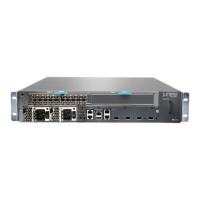CHAPTER 22
Troubleshooting Components
•
Troubleshooting Resources for MX5, MX10, MX40, and MX80 Routers on page 167
•
Troubleshooting the MX5, MX10, MX40, and MX80 Fan Tray on page 169
•
Troubleshooting the MX5, MX10, MX40, and MX80 MICs on page 170
•
Troubleshooting the MX5, MX10, MX40, and MX80 Power Supplies on page 170
Troubleshooting Resources for MX5, MX10, MX40, and MX80 Routers
•
Command-Line Interface on page 167
•
Chassis and Interface Alarm Messages on page 167
•
Front Panel LEDs on page 168
•
Component LEDs on page 168
Command-Line Interface
The Junos OS command-line interface (CLI) is the primary tool for controlling and
troubleshooting router hardware, the Junos OS, routing protocols, and network
connectivity. CLI commands display information from routing tables, information specific
to routing protocols, and information about network connectivity derived from the ping
and traceroute utilities.
You enter CLI commands on one or more external management devices connected to
ports on the front panel.
For information about using the CLI to troubleshoot the Junos OS, see the appropriate
Junos OS configuration guide.
Chassis and Interface Alarm Messages
When the Routing Engine detects an alarm condition, it lights the red or yellow alarm
LED on the front panel as appropriate. To view a more detailed description of the alarm
cause, issue the show chassis alarms command:
user@host> show chassis alarms
167Copyright © 2017, Juniper Networks, Inc.

